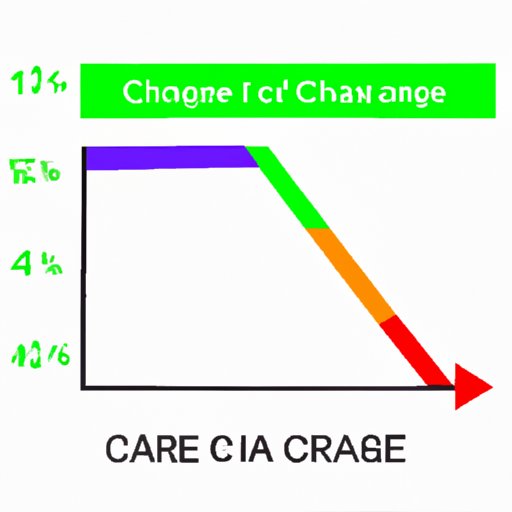
Introduction
If you’ve ever wondered how to calculate the average rate of change, you’re not alone. This mathematical concept is used in a variety of real-life scenarios to help determine trends and make predictions. Whether you are studying calculus or just need to calculate a basic math problem, understanding how to find the average rate of change is important.
In this beginner’s guide, we’ll explore what the average rate of change is, why it is important, and how to calculate it step-by-step. We’ll also provide practical tips for making the process easier and quicker and reveal advanced tips and tricks for finding the average rate of change like a math genius.
Understanding the Concept of Average Rate of Change
Before we dive into how to find the average rate of change, let’s first understand what it is and why it is important.
The average rate of change is the rate at which a quantity changes over a specified period of time. In other words, it’s the average speed at which something changes. This concept is used in a variety of real-life scenarios, such as calculating the average rate of change of a population or the average rate of change of stock prices.
In math, finding the average rate of change is important because it helps us determine the trend of a function. For example, we can use the average rate of change to determine the slope of a line or the derivative of a curve. Understanding the average rate of change is also essential for the study of calculus.
A Beginner’s Guide to Solving for the Rate of Change
To understand how to find the average rate of change, it’s important to first understand how to find the rate of change.
The rate of change is the change in y divided by the change in x. In other words:
Rate of Change = (y2 – y1) / (x2 – x1)
Let’s look at an example. If we want to find the rate of change between the points (1, 2) and (3, 6), we would calculate it like this:
Rate of Change = (6 – 2) / (3 – 1) = 2
This means that the rate of change between the points is 2. We can interpret this as the slope of the line between the two points.
We can also represent the rate of change graphically. The rate of change is represented by slope, which is the rise over run of a line. In the example above, the rise is 4 (6 – 2) and the run is 2 (3 – 1), so the slope is 2.
Mastering the Art of Finding the Average Rate of Change
Now that we understand how to find the rate of change, let’s look at how to find the average rate of change.
The average rate of change is the total change in y divided by the total change in x. In other words:
Average Rate of Change = (y2 – y1) / (x2 – x1)
Unlike the rate of change, which is calculated between two specific points, the average rate of change is calculated over a range of values. For example, if we want to find the average rate of change between x = 1 and x = 5 for the equation y = 2x + 1, we would first find the y values for x = 1 and x = 5:
y(1) = 2(1) + 1 = 3
y(5) = 2(5) + 1 = 11
Next, we would use the formula for the average rate of change:
Average Rate of Change = (11 – 3) / (5 – 1) = 2
This means that the average rate of change between x = 1 and x = 5 for this equation is 2.
Finding the average rate of change can be more challenging than finding the rate of change because it requires calculating over a range of values. Let’s look at some illustrated examples to help make the process clearer.
5 Simple Steps to Calculate the Average Rate of Change
To calculate the average rate of change, follow these five simple steps:
1. Identify the values of x and y for the given range.
2. Find the difference between the final and initial values of y.
3. Find the difference between the final and initial values of x.
4. Divide the difference in y by the difference in x.
5. Simplify if necessary.
Let’s look at an example. If we want to find the average rate of change between x = 1 and x = 5 for the equation y = 2x + 1, we would follow these five steps:
1. Identify the values of x and y for the given range: x = 1, 5 and y = 3, 11
2. Find the difference between the final and initial values of y: 11 – 3 = 8
3. Find the difference between the final and initial values of x: 5 – 1 = 4
4. Divide the difference in y by the difference in x: 8 / 4 = 2
5. Simplify if necessary: There is no need to simplify in this case.
This means that the average rate of change between x = 1 and x = 5 for y = 2x + 1 is 2.
To make the process easier and quicker, it’s important to look for patterns and shortcuts. For example, if the function is a linear equation, we know that the average rate of change is equal to the slope of the line.

How to Find the Average Rate of Change Like a Math Genius
If you want to find the average rate of change quickly and accurately, there are some advanced tips and tricks you can use.
One method is to use shortcuts. For example, if the function is given as a table of values, we can use the formula:
Average Rate of Change = (Σ(Δy)) / (Σ(Δx))
where Σ(Δy) is the sum of the changes in y and Σ(Δx) is the sum of the changes in x.
Another method is to use calculus. We can find the average rate of change for a curve by integrating the function and dividing by the range of x values. For example, if we want to find the average rate of change of the function y = f(x) over the interval [a, b], we would use the formula:
Average Rate of Change = (1 / (b – a)) ∫[a,b] f(x) dx
This method may be more challenging than the previous methods, but it can be useful for finding the average rate of change of complex curves.
It’s also important to check your work and avoid common mistakes. One common mistake is to calculate the rate of change instead of the average rate of change. Double-checking your calculations and ensuring that you are using the correct formula can help you avoid mistakes.
A Quick Tutorial on Finding the Average Rate of Change
To recap, here are the key points to remember when finding the average rate of change:
– The average rate of change is the total change in y divided by the total change in x over a specified period of time.
– The rate of change is the change in y divided by the change in x between two specific points.
– To find the average rate of change, follow these five simple steps: identify the values of x and y, find the difference in y and x, divide the difference in y by the difference in x, and simplify if necessary.
– Advanced methods for finding the average rate of change include using shortcuts and calculus.
– To avoid mistakes, double-check your calculations and ensure you are using the correct formula.
Solving for the Average Rate of Change: Tips and Tricks
Additional tips and tricks for solving for the average rate of change efficiently include looking for patterns and shortcuts, practicing with example problems, and using technology such as calculators and graphing software.
It’s also important to consider how the average rate of change can be applied in other math problems. For example, it can be used to determine the acceleration of an object or the rate of change of a function over time.
In summary, finding the average rate of change is an important concept in math that can be used in a variety of real-life scenarios. By understanding the steps to find the average rate of change, using practical tips and shortcuts, and checking your work, you can easily solve problems and become a math genius.





